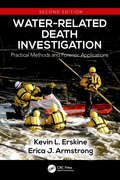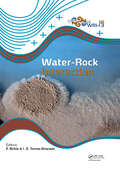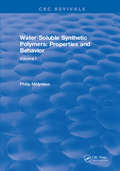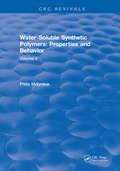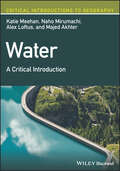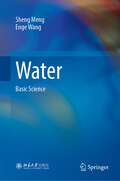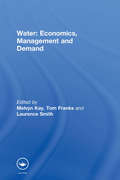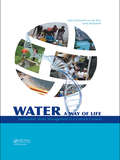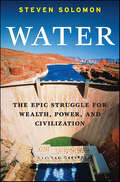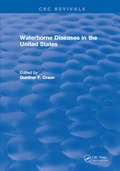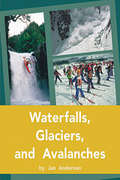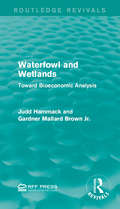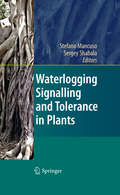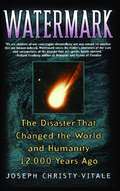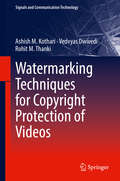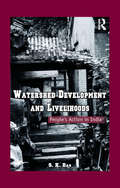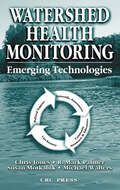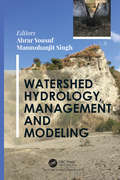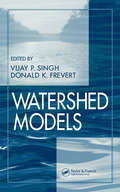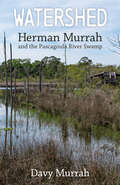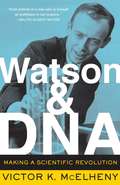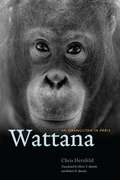- Table View
- List View
Water-Related Death Investigation: Practical Methods and Forensic Applications
by Kevin L. Erskine Erica J. ArmstrongNearly ten years after the first edition of Water-Related Death Investigation: Practical Methods and Forensic Applications, water death cases continue to be improperly investigated. The pathologist’s report can determine the cause of death as a drowning, but the manner of death is the most challenging to prove. The report will not determine if a victim jumped into the water to commit suicide, fell into the water accidentally, or was pushed in as a homicidal act. Many drowning cases do not reflect injury to the body, so evidence collected at the scene plays a vital role. The importance of an on-scene body assessment cannot be overemphasized. Often, the body evidence begins to change rapidly upon recovery and may not be present during an autopsy. Written statements on the scene are an effective tool to use to determine the accuracy of information given to arriving officers. These statements need to be written by the witnesses themselves as well as the reporting person. The "Show Me" technique can also help reveal discrepancies in a person’s version of what occurred as well as aid in providing the most details to an incident as is humanly possible. This second edition includes updated information on the latest technology to assist water death investigators. Parabon Snapshot can help determine the faceless identity of skeletal remains and help locate potential suspects using the science of DNA. Drones can aid in locating missing persons as well as human remains, even months after death. Updated information is provided regarding fingerprints from submerged objects, and Carbon-14 can help determine the origin of a found corpse. Key Features: Thoroughly reviews the physiological aspects of drowning Reveals the investigative characteristics inherent to various scenes of water-related deaths Highlights certain "red flag" indicators that may point to foul play or scene staging Outlines autopsy protocols, trial preparation, and expert witness testimony Provides numerous case studies and numerous illustrations to further clarify key points presented in the text Coauthored by a Master Water Death Investigator and an experienced forensic pathologist, Water-Related Death Investigation: Practical Methods and Forensic Applications, Second Edition merges the essentials of evidence collection and field investigation with autopsy best practices and laboratory testing. It will continue to serve as a valuable resource for the various professionals involved in these cases.
Water-Rock Interaction XIII
by Peter Birkle Ignacio S. Torres-AlvaradoIn the late 18th century, Neptunists and Plutonists had controversial opinions about the formation of the Earth and its lithological units. The former believed that rocks formed from the crystallization of minerals in the early Earth's oceans, the latter believed that rocks were formed in fire. Both theories ignored the importance of continuous wat
Water-Soluble Synthetic Polymers: Volume I: Properties and Behavior
by Philip MolyneuxAlthough several monographs and reviews have appeared on individual polymers of this type, and their applications and other technical aspects have also been discussed, this is apparently the first book to deal with the physical chemistry of water-soluble synthetic polymers as a group. This collective survey enables their properties and behaviour to be compared, and to be correlated with their molecular structures for predictive purposes. However, this has made it necessary to critically re-appraise much of the earlier fundamental work, so that current discussion of more recent work can be put on ta proper basis. Thus, of the 1800 or so references cited, the middle two-thirds related to the twenty-year period centred on about 1968. Nevertheless, sufficient key recent references have also been included so that the existing ‘state of the art is delineated.
Water-Soluble Synthetic Polymers: Volume II: Properties and Behavior
by Philip MolyneuxAlthough several monographs and reviews have appeared on individual polymers of this type, and their applications and other technical aspects have also been discussed, this is apparently the first book to deal with the physical chemistry of water-soluble synthetic polymers as a group. This collective survey enables their properties and behaviour to be compared, and to be correlated with their molecular structures for predictive purposes. However, this has made it necessary to critically re-appraise much of the earlier fundamental work, so that current discussion of more recent work can be put on ta proper basis. Thus, of the 1800 or so references cited, the middle two-thirds related to the twenty-year period centred on about 1968. Nevertheless, sufficient key recent references have also been included so that the existing ‘state of the art is delineated.
Water: A Critical Introduction (Critical Introductions to Geography)
by Alex Loftus Naho Mirumachi Katie Meehan Majed AkhterDiscover the hydrosocial cycle and the impact of power, knowledge, and scarcity on water rights and use through this engaging and student-friendly textbook In Water: A Critical Introduction, a team of distinguished researchers delivers an expert examination of our most pressing water-related challenges, arguing that flows of water are shaped by social practices and geometries of power. Combining first-hand research and headline case studies, the authors reveal the hydrosocial relations often hidden in mainstream accounts of water, delving into current issues like water scarcity, floods, global water governance, legal conflicts, human rights, potable water provision, health, the water-food-energy nexus, and much more. Spanning five centuries, this comprehensive volume reflects on how imperial expansion has shaped hydrosocial relations in and between Europe, Asia, Africa, and the Americas, how water demand has changed over time, and how this change impacted lifestyle. As the first major text to synthesize critical water research in both local and global perspectives, this book is anchored by clear and compelling arguments — the "four planks" — and supported by the authors' original research and up-to-date synthesis of the latest critical research on major water problems. It also includes maps, illustrations, and additional learning materials to be used by educators. Readers will find: A lively and thorough introduction that explains why a critical approach is necessary to fully understand our current water challenges, with a focus on the "skeptical superhero" A global approach to key debates in water issues, including large dams, privatization, transboundary conflicts, agriculture and irrigation, water and sanitation provision, human rights, governance dilemmas, and the Sustainable Development Goals Comprehensive explorations of the roles played by expert knowledge, global capital, climate change, and justice struggles in the hydrosocial cycle Critical theoretical perspectives that integrate environmental social sciences, feminist critique, and a broadly defined political economy with the specificities of water resources Fulsome treatments of water governance, science, and management, including the origins and implications of neoliberal approaches to the privatization, commodification, and financialization of water An accessible text that "invites the reader" on a critical journey Water: A Critical Introduction is a key text for advanced high school, undergraduate, and graduate students who want a keener understanding of trends in environmental management, political ecology, and water governance, science, and engineering. Written with an interdisciplinary audience in mind, this book will benefit students taking courses in environmental studies, environmental law, geopolitics, international studies, human geography, hydrology, engineering, environmental economics, and related disciplines.
Water: Basic Science
by Sheng Meng Enge WangThis book highlights the fundamentals for understanding the essential problems and latest progresses in basic water science. Water is the most abundant, fundamental and important matter in nature. Arguably it is also the material that human beings study the most but misunderstand the most. Compared with the environmental science and engineering research activities on water resources, water pollution and water usage closely related to social problems at the macro level, basic scientific research on water at the molecular level has just emerged, the impact of which is not fully recognized yet. This book is devoted to introducing some important advances in the field of basic water science in past decades, with a particular emphasis on recent results on water and the interactions between water and solid surfaces at the molecular level. Starting from introducing concepts and popular theoretical and experimental methods for basic water research, this book mainly focuses on the atomic composition, electronic structure, and physicochemical properties of water molecules, water clusters and water layers (including surface water layers and water surface layers), rules for water adsorption on metals, oxides, and other typical solid surfaces such as salt, as well as the microscopic processes and mechanisms of water diffusion, wetting, decomposition and phase transformations under a variety of conditions. It is a good reference book for students and researchers in water-related science.
Water: Economics, Management and Demand
by Melvyn Kay Laurence Smith Tom FranksWater is often seen as a free commodity. However, this is rarely the case as demand for water is increasing significantly across the world. This book focuses on the key roles of irrigaiton and drainage in the debate on water. Irrigation is a major player in the demand for water and already accounts for between 70-80% of the total world consumption.
Water: FOSS Science Stories
by University of California at Berkeley Lawrence Hall of ScienceNIMAC-sourced textbook
Water: Sustainable water management in a cultural context
by A.J.M. (Lida) Schelwald-van der Kley Linda ReijerkerkWhy do many water management projects, begun with the best of intentions, still fail? How is it that large infrastructural water works often encounter opposition? Is it perhaps, among other things, the lack of attention for the cultural context? These and other intriguing questions are dealt with in this book. The authors, having 20 years of e
Water: The Epic Struggle for Wealth, Power, and Civilization
by Steven Solomon“I read this wide-ranging and thoughtful book while sitting on the banks of the Ganges near Varanasi—it's a river already badly polluted, and now threatened by the melting of the loss of the glaciers at its source to global warming. Four hundred million people depend on it, and there's no backup plan. As Steven Solomon makes clear, the same is true the world over; this volume will give you the background to understand the forces that will drive much of 21st century history.” —Bill McKibben In Water, esteemed journalist Steven Solomon describes a terrifying—and all too real—world in which access to fresh water has replaced oil as the primary cause of global conflicts that increasingly emanate from drought-ridden, overpopulated areas of the world. Meticulously researched and undeniably prescient, Water is a stunningly clear-eyed action statement on what Robert F Kennedy, Jr. calls “the biggest environmental and political challenge of our time.”
Water: Up, Down, And All Around (Amazing Science Ser.)
by Natalie M. RosinskyDescribes the water cycle and the importance of water, explaining evaporation and condensation, dew and frost, and the three states of water.
Waterborne Diseases in the US
by Gunther F. CraunThis book examines, in both a current and historical context, water-related illness in the U.S. Emphasis is placed upon the transmission of infectious diseases through contaminated drinking water supplies and those deficiencies in water supply systems which allow waterborne outbreaks to occur. Chapters have been included on the important etiologic agents responsible for waterborne outbreaks in the U.S., surveillance activities, regulations, water treatment to prevent the occurrence of waterborne outbreaks and procedures for investigating waterborne outbreaks. For completeness, discussion have been included on illnesses contracted by ingestion of contact with waters for bathing , swimming, or wading and chronic ingestion of low levels of chemical contaminants in drinking water; however, because of space limitations there are necessarily brief, and the reader is directed toward the provided references, which discuss these subjects in more depth.
Waterfalls, Glaciers, and Avalanches (Rigby PM Plus Non Fiction Ruby (Levels 27-28), Fountas & Pinnell Select Collections Grade 3 Level Q)
by Jan AndersonThis text focuses upon the movement and flow of water, ice and snow, and how this affects the environment and the lifestyles of the people who live there. Text forms include a labelled diagram, a diary excerpt and a newspaper report.
Waterfowl and Wetlands: Toward Bioeconomic Analysis (Routledge Revivals)
by Judd Hammack Gardner Mallard Brown Jr.Originally published in 1974, Waterfowl and Wetlands analyses waterfowl hunting patterns in the late sixties in the hopes of protecting waterfowl resources such as wetlands. Wetlands are obviously an important resource for migratory waterfowl however they are often drained for agricultural purposes which can have dramatic effects on waterfowl population. This study aims to explore the issues surrounding waterfowl and wetlands in an attempt to determine their value to hunters, farmers and the general public. This study will be of interest to students of Environmental Studies.
Waterlogging Signalling and Tolerance in Plants
by Sergey Shabala Stefano MancusoWaterlogging is a major problem for plant cultivation in many regions of the world. This book combines both academic and practical aspects of this topic. Based on recent progress in cell and molecular biology, various facets of waterlogging signalling and tolerance are addressed, starting from the molecular level, through membrane transport, cells and plant organs, up to the whole organism. Leading scientists contribute 13 chapters grouped into the following main parts: whole-plant regulation, intracellular signalling, membrane transporters in waterlogging tolerance and agronomical and environmental aspects. This work offers a universal handbook for any researcher or agronomist interested in the impact of waterlogging in plants.
Watermark
by Christy-VitaleTHE ECHOES OF OUR PAST Twelve thousand years ago, the human race barely escaped annihilation when a piece of exploded star passed through our solar system, unleashing an apocalypse. Great fires raged, mountains rose and fell, a maelstrom of cosmic debris bombarded Earth, continents broke apart, and oceans swept across the land. Millions of people, animals, and plants perished almost overnight. Entire societies, cultures, and belief systems were lost forever. The resulting aftershock shaped humanity for thousands of years, and continues to haunt us to this day. This is not fiction. This is history. THE TRUTHS OF THE PRESENT Using authoritative source material and an understanding of mankind's aptitude for the transmission of factual knowledge through myth and legend, Joseph Christy-Vitale dramatically unveils a past unlike any proposed by either religion or science, viewing the global catastrophe as living history, since the traumatic effects of that terrible event affect us as a species even today. THE PATHS OF THE FUTURE Providing an insight into where our troubled view of the world originated, Watermark tells the true story of how humanity's brush with extinction still pervades our lives -- and offers the first step to recovering what we lost so long ago: a healthy, balanced view of the world.
Watermarking Techniques for Copyright Protection of Videos (Signals and Communication Technology)
by Rohit M. Thanki Ashish M. Kothari Vedvyas DwivediThe book provides copyright protection approaches for videos using watermarking. The various watermarking techniques using various transforms such as discrete cosine transform (DCT), discrete wavelet transform (DWT) and singular value decomposition (SVD) for videos are presented. The book also provides video watermarking approach using compressive sensing (CS) theory. The presented watermarking techniques are designed and implemented using color digital videos. The performance of the presented techniques is evaluated using Peak Signal to Noise Ratio (PSNR) and Normalized Correlation (NC).
Waters of the World: The Story of the Scientists Who Unraveled the Mysteries of Our Oceans, Atmosphere, and Ice Sheets and Made the Planet Whole
by Sarah DryA Nature Top Ten Book of the Year: “Immensely readable” accounts of seven pioneers who were at the forefront of what we now call climate science (New York Review of Books).One of Booklist’s Top Ten Sci-Tech Books of the YearFrom the glaciers of the Alps to the towering cumulonimbus clouds of the Caribbean and the unexpectedly chaotic flows of the North Atlantic, Waters of the World is a tour through 150 years of the history of a significant but underappreciated idea: that the Earth has a global climate system made up of interconnected parts, constantly changing on all scales of both time and space. A prerequisite for the discovery of global warming and climate change, this idea was forged by scientists studying water in its myriad forms. This is their story.Linking the history of the planet with the lives of those who studied it, Sarah Dry follows the remarkable scientists who summited volcanic peaks to peer through an atmosphere’s worth of water vapor, cored mile-thick ice sheets to uncover the Earth’s ancient climate history, and flew inside storm clouds to understand how small changes in energy can produce both massive storms and the general circulation of the Earth’s atmosphere. Each toiled on his or her own corner of the planetary puzzle. Gradually, their cumulative discoveries coalesced into a unified working theory of our planet’s climate.We now call this field climate science, and in recent years it has provoked great passions, anxieties, and warnings. But no less than the object of its study, the science of water and climate is—and always has been—evolving. By revealing the complexity of this history, Waters of the World delivers a better understanding of our planet’s climate at a time when we need it the most.“One of the richest books I have ever read . . . a beautifully written, episodic, yet comprehensive, history of the diverse scientific underpinnings of climate science over the past two hundred years.” —Environmental History“Smart, compelling, and timely . . . By focusing on specific scientists, Dry gifts readers with entertaining portraits of some thoroughly interesting if largely unknown individuals.”—Booklist (starred review)
Watershed Development and Livelihoods: People’s Action in India
by S.K. DasThis book analyses the empowerment process of the Bhil as a result of the implementation of the watershed project in Jhabua. This visionary project, planned and implemented by the Bhil community, has put in place an integrated strategy that has given them control over their livelihood. It is examined against the backdrop of a framework that links three important aspects-biophysical (resource management and ecological balance), socio-economic (productivity, agricultural growth and livelihood support) and institutional (sustainable resource use, equity and benefit-cost sharing); and their complex interactions.
Watershed Health Monitoring: Emerging Technologies
by Chris Jones Michael Walters R. Mark Palmer Susan MotkalukWatershed Health Monitoring: Emerging Technologies is a concise reference that defines the concept of watershed health and explains that monitoring the health of watersheds is a critical precursor to adaptive resource management on a watershed basis. The focus of the text is a clear description of an innovative "Closed Loop" model that specifies fo
Watershed Hydrology, Management and Modeling
by Abrar Yousuf Manmohanjit SinghThe book provides a comprehensive insight into watersheds and modeling of the hydrological processes in the watersheds. It covers the concepts of watershed hydrology and watershed management in depth. The basic types, of soil erosion and its measurement and estimation of runoff and soil loss from the small and large watersheds are discussed. Recent advances in the watershed management like the application of remote sensing and GIS and hydrological models are a part of the book. The book serve as a guide for professional and competitive examinations for undergraduate students of Agriculture and Agricultural Engineering and graduate students of Soil Science, Soil and Water Engineering, Agricultural Physics, Hydrology and Watershed Management.
Watershed Models
by Vijay P. Singh Donald K. FrevertWatershed modeling is at the heart of modern hydrology, supplying rich information that is vital to addressing resource planning, environmental, and social problems. Even in light of this important role, many books relegate the subject to a single chapter while books devoted to modeling focus only on a specific area of application. Recognizing the
Watershed: Herman Murrah and the Pascagoula River Swamp
by Davy MurrahThe Pascagoula River is the largest unobstructed river in the contiguous United States. Because of this lack of restraint, the river has been left to rise and fall naturally with the seasons, overflowing annually into the adjoining bottomland forest. This phenomenon makes the Pascagoula River one of the wildest rivers, surrounded by some of the most ecologically diverse woodlands, in North America.Herman Murrah (1935–2002) lived his entire life on the banks and in the swamp surrounding this river in southeast Mississippi. Watershed: Herman Murrah and the Pascagoula River Swamp recounts pivotal moments in Herman’s life and in Mississippi’s conservation history more broadly. In this book, Herman’s eldest son, Davy, details the adventures that continue to inspire young conservationists in the fight to protect our remaining natural ecosystems.As a young adult, Herman worked as a game warden in the Pascagoula River Swamp. When the Pascagoula Hardwood Company, then owners of the swamp, decided to sell the vast tract of forest for clearcutting, Herman was incensed. Determined to protect this natural wonder, Herman teamed up with other visionaries to persuade the State of Mississippi to purchase the land and preserve it in perpetuity to the benefit of future generations of humans and wildlife alike. Eventually, the state agreed and finalized the purchase. Herman was appointed area manager for the upper portion of the newly designated Pascagoula River Wildlife Management Area. He dedicated the remainder of his life to preserving, protecting, and improving the swamp for the good of south Mississippi.
Watson & DNA: Making A Scientific Revolution (A Merloyd Lawrence Book)
by Victor K. McelhenyA real page-turner. . . . If Victor McElheny is not already a prince among science writers, this book should elevate him to that high position. -Judah Folkman, Nature Medicine
Wattana: An Orangutan in Paris
by Chris Herzfeld Oliver Y. Martin Robert D. MartinShe likes tea, sews, draws on papers and is a self-taught master of tying and untying knots. But she is not a crafty woman of the DIY set: she is Wattana, an orangutan who lives in the Jardin des Plantes Zoo in Paris. And it is in Paris where Chris Herzfeld first encounters and becomes impressed by Wattana and her exceptional abilities with knots. In Wattana: An Orangutan in Paris Herzfeld tells not only Wattana's fascinating story, but also the story of orangutans and other primates--including bonobos, chimpanzees, and gorillas--in captivity. Offering a uniquely intimate look at the daily lives of captive great apes, Herzfeld uses Wattana's life to trace the history of orangutans from their first arrival in Europe in 1776 to the inhabitants of the Zoo of Paris and other zoos today. She provides a close look at the habits, technical know-how, and skills of Wattana, who, remarkably, uses strings, paper rolls, rope, and even pieces of wood to make things. And she thoughtfully explores how apes individually--and often with ingenuity--come to terms with and adapt to their captive environments and caretakers. Through these stories, Wattana sympathetically reveals the extraordinary psychology and distinctive personalities of great apes as well as the interconnections between animal and human lives, especially in zoos. Scientists predict that orangutans will disappear from the wild by 2030, and captive animals like Wattana may, as a result, provide our best chance to understand and appreciate their astonishing intelligence and abilities. Wattana, the accomplished maker of knots, is the hero of this poignant book, which will enthrall anyone curious about the lives of our primate cousins.
